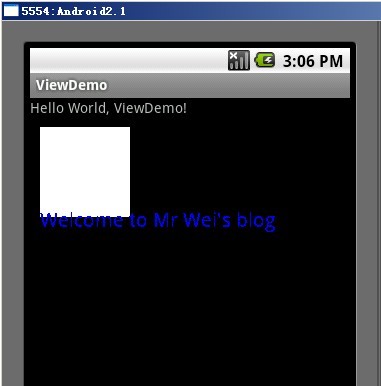今天我们的教程是根据前面一节扩展进行的,如果你没有看,请点击Android高手进阶教程(三)查看第三课,这样跟容易方便你的理解!
在xml文件里定义控件的属性,我们已经习惯了android:attrs="",那么我们能不能定义自己的属性能,比如:test:attrs=""呢?答案是肯定的.
进入主题。大致以下步骤:
一、在res/values文件下定义一个attrs.xml文件.代码如下:
-
<?xmlversion="1.0"encoding="utf-8"?>
-
<resources>
-
<declare-styleablename="MyView">
-
<attrname="textColor"format="color"/>
-
<attrname="textSize"format="dimension"/>
-
</declare-styleable>
-
</resources>
二、我们在MyView.java代码编写如下,其中下面的构造方法是重点,我们获取定义的属性R.sytleable.MyView_textColor,获取方法中后面通常设定默认值(float textSize = a.getDimension(R.styleable.MyView_textSize,36);),防止我们在xml文件中没有定义.从而使用默认值!
MyView就是定义在<declare-styleable name="MyView"></declare-styleable>里的 名字,获取里面属性用名字_ 属性连接起来就可以.TypedArray通常最后调用.recycle()方法,为了保持以后使用该属性一致性!
-
publicMyView(Contextcontext,AttributeSetattrs)
-
{
-
super(context,attrs);
-
mPaint=newPaint();
-
-
TypedArraya=context.obtainStyledAttributes(attrs,
-
R.styleable.MyView);
-
-
inttextColor=a.getColor(R.styleable.MyView_textColor,
-
0XFFFFFFFF);
-
floattextSize=a.getDimension(R.styleable.MyView_textSize,36);
-
-
mPaint.setTextSize(textSize);
-
mPaint.setColor(textColor);
-
-
a.recycle();
-
}
MyView.javaMyView控件全部代码如下:
-
packagecom.android.tutor;
-
importandroid.content.Context;
-
importandroid.content.res.TypedArray;
-
importandroid.graphics.Canvas;
-
importandroid.graphics.Color;
-
importandroid.graphics.Paint;
-
importandroid.graphics.Rect;
-
importandroid.graphics.Paint.Style;
-
importandroid.util.AttributeSet;
-
importandroid.view.View;
-
publicclassMyViewextendsView{
-
privatePaintmPaint;
-
privateContextmContext;
-
privatestaticfinalStringmString="WelcometoMrWei'sblog";
-
-
publicMyView(Contextcontext){
-
super(context);
-
mPaint=newPaint();
-
}
-
publicMyView(Contextcontext,AttributeSetattrs)
-
{
-
super(context,attrs);
-
mPaint=newPaint();
-
-
TypedArraya=context.obtainStyledAttributes(attrs,
-
R.styleable.MyView);
-
-
inttextColor=a.getColor(R.styleable.MyView_textColor,
-
0XFFFFFFFF);
-
floattextSize=a.getDimension(R.styleable.MyView_textSize,36);
-
-
mPaint.setTextSize(textSize);
-
mPaint.setColor(textColor);
-
-
a.recycle();
-
}
-
@Override
-
protectedvoidonDraw(Canvascanvas){
-
-
super.onDraw(canvas);
-
-
mPaint.setStyle(Style.FILL);
-
-
-
canvas.drawRect(newRect(10,10,100,100),mPaint);
-
-
mPaint.setColor(Color.BLUE);
-
-
canvas.drawText(mString,10,110,mPaint);
-
}
-
}
三、将我们自定义的MyView加入布局main.xml文件中,并且使用自定义属性,自定义属性必须加上:
"xmlns:test="http://schemas.android.com/apk/res/com.android.tutor" ,test是自定义属性的前缀, com.android.tutor是我们包名.
main.xml全部代码如下:
-
<?xml
-
version="1.0"encoding="utf-8"?>
-
<LinearLayout
-
xmlns:android="http://schemas.android.com/apk/res/android"
-
-
xmlns:test="http://schemas.android.com/apk/res/com.android.tutor"
-
android:orientation="vertical"
-
android:layout_width="fill_parent"
-
android:layout_height="fill_parent"
-
>
-
<TextView
-
android:layout_width="fill_parent"
-
android:layout_height="wrap_content"
-
android:text="@string/hello"
-
/>
-
<com.android.tutor.MyView
-
android:layout_width="fill_parent"
-
android:layout_height="fill_parent"
-
test:textSize="20px"
-
test:textColor="#fff"
-
/>
-
</LinearLayout>
四、运行之效果如下图:

参考文章二:
Android 自定义View 己经不是什么新鲜话题,Android Api提供了一大堆基础组件给我们,需要什么特定功能还需要我们继承它们然后定制更加丰富的功能。前面有篇文章也说过为自定义VIEW添加属性,但只是一笔带过,这里就拿这点来说说吧。
第一种添加属性的方法,之前我也是经常使用这种写法,代码如下:
packagecom.terry.attrs;
importandroid.content.Context;
importandroid.util.AttributeSet;
importandroid.widget.EditText;
importandroid.widget.LinearLayout;
importandroid.widget.TextView;
publicclassEditTextExt1extendsLinearLayout{
privateStringText="";
publicEditTextExt1(Contextcontext){
this(context,null);
//TODOAuto-generatedconstructorstub
}
publicEditTextExt1(Contextcontext,AttributeSetattrs){
super(context,attrs);
//TODOAuto-generatedconstructorstub
intresouceId=-1;
TextViewtv=newTextView(context);
EditTextet=newEditText(context);
resouceId=attrs.getAttributeResourceValue(null,"Text",0);
if(resouceId>0){
Text=context.getResources().getText(resouceId).toString();
}else{
Text="";
}
tv.setText(Text);
addView(tv);
addView(et,newLinearLayout.LayoutParams(LayoutParams.FILL_PARENT,
LayoutParams.WRAP_CONTENT));
this.setGravity(LinearLayout.VERTICAL);
}
}
这种写法,简单明了,不需要额外XML的配置,就可以在我们的VIEW文件下使用。
以上代码通过构造函数中引入的AttributeSet 去查找XML布局的属性名称,然后找到它对应引用的资源ID去找值。使用也时分方便。所以一直以来我也是很喜欢这种写法。
如上,自定好VIEW文件就可以在XML布局下如此使用:
<com.terry.attrs.EditTextExt1android:id="@+id/ss3"
android:layout_width="wrap_content"android:layout_height="wrap_content"
Text="@string/app_name"></com.terry.attrs.EditTextExt1>
好了,这是第一种为VIEW注册属性的写法,比较简单就不多介绍。
下面是第二为VIEW注册属性的写法,这里也要重点说说第二种注册 属性的写法和使用要点,先看一下JAVA代码要如何编写:
packagecom.terry.attrs;
importandroid.content.Context;
importandroid.content.res.TypedArray;
importandroid.util.AttributeSet;
importandroid.widget.EditText;
importandroid.widget.LinearLayout;
importandroid.widget.TextView;
publicclassEditTextExtextendsLinearLayout{
publicEditTextExt(Contextcontext){
this(context,null);
//TODOAuto-generatedconstructorstub
}
publicEditTextExt(Contextcontext,AttributeSetattrs){
super(context,attrs);
//TODOAuto-generatedconstructorstub
intresouceId=-1;
TypedArraytypeArray=context.obtainStyledAttributes(attrs,
R.styleable.EditTextExt);
TextViewtv=newTextView(context);
EditTextet=newEditText(context);
intN=typeArray.getIndexCount();
for(inti=0;i<N;i++){
intattr=typeArray.getIndex(i);
switch(attr){
caseR.styleable.EditTextExt_Oriental:
resouceId=typeArray.getInt(R.styleable.EditTextExt_Oriental,
0);
this.setOrientation(resouceId==1?LinearLayout.HORIZONTAL
:LinearLayout.VERTICAL);
break;
caseR.styleable.EditTextExt_Text:
resouceId=typeArray.getResourceId(
R.styleable.EditTextExt_Text,0);
tv.setText(resouceId>0?typeArray.getResources().getText(
resouceId):typeArray
.getString(R.styleable.EditTextExt_Text));
break;
}
}
addView(tv);
addView(et);
typeArray.recycle();
}
}
如上代码,跟前面代码一样。还是用的一个EDITTEXT和TEXTVIEW做基础组件。下面我们一步步分析上面的代码:
R.styleable.EditTextExt 代码的是一个attrs指向的一个declare-styleable 的标签,如下代码:
<?xmlversion="1.0"encoding="UTF-8"?>
<resources>
<declare-styleablename="EditTextExt">
<attrname="Text"format="reference|string"></attr>
<attrname="Oriental">
<enumname="Horizontal"value="1"></enum>
<enumname="Vertical"value="0"></enum>
</attr>
</declare-styleable>
</resources>
这个文件位于,values下的attrs.xml目录下面,我比较喜欢一个自定义View 对应一个declare-styleable标签。
Tip:一个自定义View 第一部分的代码,
TypedArraytypeArray=context.obtainStyledAttributes(attrs,
R.styleable.EditTextExt);
指定为一个declare-styleable,而在declare-styleable 下的attr (即各属性)Android 的ADT 将会自动生成为declare-styleable的name 名字加上“_”加上对应attr(即属性名称)的名称,如上(EditTextExt_Text)我们要得到Text 就需要R.styleable.EditTextExt_Text,这一点的话可以看看R.java生成文件:
publicstaticfinalclassstyleable{
/**AttributesthatcanbeusedwithaEditTextExt.
<p>Includesthefollowingattributes:</p>
<table>
<colgroupalign="left"/>
<colgroupalign="left"/>
<tr><th>Attribute</th><th>Description</th></tr>
<tr><td><code>{@link#EditTextExt_Orientalcom.terry.attrs:Oriental}</code></td><td></td></tr>
<tr><td><code>{@link#EditTextExt_Textcom.terry.attrs:Text}</code></td><td></td></tr>
</table>
@see#EditTextExt_Oriental
@see#EditTextExt_Text
*/
publicstaticfinalint[]EditTextExt={
0x7f010000,0x7f010001
};
/**
<p>Thissymbolistheoffsetwherethe{@linkcom.terry.attrs.R.attr#Oriental}
attribute'svaluecanbefoundinthe{@link#EditTextExt}array.
<p>Mustbeoneofthefollowingconstantvalues.</p>
<table>
<colgroupalign="left"/>
<colgroupalign="left"/>
<colgroupalign="left"/>
<tr><th>Constant</th><th>Value</th><th>Description</th></tr>
<tr><td><code>Horizontal</code></td><td>1</td><td></td></tr>
<tr><td><code>Vertical</code></td><td>0</td><td></td></tr>
</table>
@attrnameandroid:Oriental
*/
publicstaticfinalintEditTextExt_Oriental=1;
/**
<p>Thissymbolistheoffsetwherethe{@linkcom.terry.attrs.R.attr#Text}
attribute'svaluecanbefoundinthe{@link#EditTextExt}array.
<p>Maybeareferencetoanotherresource,intheform"<code>@[+][<i>package</i>:]<i>type</i>:<i>name</i></code>"
ortoathemeattributeintheform"<code>?[<i>package</i>:][<i>type</i>:]<i>name</i></code>".
<p>Maybeastringvalue,using'//;'toescapecharacterssuchas'//n'or'//uxxxx'foraunicodecharacter.
@attrnameandroid:Text
*/
publicstaticfinalintEditTextExt_Text=0;
};
好了,上述的代码写完,我们要在XML布局如何使用呢?这个会跟Android 提供的基础组件的使用方法是一致的。首先,我们要为其提供一个引用包名如下:
xmlns:android="http://schemas.android.com/apk/res/android"
xmlns:terry="http://schemas.android.com/apk/res/com.terry.attrs"
上面提供的是android 基础组件的包名,和我们自己组件的包名。
写好了包名。就可以像使用andriod 基础组件一样使用了,如下全部XML布局源码:
<?xmlversion="1.0"encoding="utf-8"?>
<LinearLayoutxmlns:android="http://schemas.android.com/apk/res/android"
xmlns:terry="http://schemas.android.com/apk/res/com.terry.attrs"
android:orientation="vertical"android:layout_width="fill_parent"
android:layout_height="fill_parent">
<TextViewandroid:layout_width="fill_parent"
android:layout_height="wrap_content"android:text="@string/hello"/>
<com.terry.attrs.EditTextExtandroid:id="@+id/ss"
android:layout_width="fill_parent"android:layout_height="wrap_content"
terry:Text="fdsafda"terry:Oriental="Vertical"></com.terry.attrs.EditTextExt>
<com.terry.attrs.EditTextExt1android:id="@+id/ss3"
android:layout_width="wrap_content"android:layout_height="wrap_content"
Text="@string/app_name"></com.terry.attrs.EditTextExt1>
</LinearLayout>
这是这两种为Android 注册 属性的使用方法,那么两者有什么区别呢?
在这里我认为起码有五点,大家可以找找看还有什么区别:
- 第二种可以编译时报错,如果编程人员随便输入什么第一种是不会报错的,第二种可以支持代码检测功能。
- 第二种写法,跟Android 属性标准写法是一致的,而且可以统一书法规则。
- 第二种写法,可以支持数据格式的验证,比如我们在attrs上注明只支持integer 那么就不可以使用字符串,这是第一种达不到的。
- 第二种写法,可以为VIEW提供选择操作,比如如上我们使用的ENUM让VIEW对应的属性支持ENUM列表,或者为其提供BOOL等只有双项选择的操作。
- 第一种写法,所有的属性必须是引用自资源(不大确定,如果朋友有什么好的DEMO麻烦共享),第二种写法,可以即支持引用资源又可以直接输入做操作,为编程带来更多的方便性。
种种都说明,第二种写法更具规范性,功能更性,代码编写 也更优雅,但个人有个人的使用习惯,我两种都喜欢用,具体看需求吧。呵呵。。。
分享到:












相关推荐
测试:Android 中自定义属性(attr.xml,TypedArray)的使用 注意:MyView(Context context,AttributeSet attrs)构造函数的实现, 和注意main.xml的LinearLayout 里加的声明 要了解:test:textSize="20px" test:...
NULL 博文链接:https://elingwange.iteye.com/blog/1285289
最近接触了Android自定义控件,涉及到自定义xml中得属性(attribute),其实也很简单,但是写着写着,发现代码不完美了,就是在attrs.xml这个文件中,发现属性冗余,于是就想有没有类似属性继承或者include之类的方法....
在Android开发中,往往要用到自定义的控件来实现我们的需求或效果。在使用自定义 控件时,难免要用到自定义属性,那怎么使用自定义属性呢? 在文件res/values/下新建attrs.xml属性文件,中定义我们所需要的属性。 ...
Android高手进阶教程之----Android 中自定义属性(attr.xml,TypedArray)的使用! .doc Android高手进阶教程之----Android中万能的BaseAdapter(Spinner,ListView,GridView)的使用!.doc Android高手进阶教程之----通过...
Android自定义Attr属性 的具体使用例子,看完之后,你就知道如何自定义控件的属性
一个模仿android L中载入视图的控件。可自定义控件的颜色、边框长度、动画时间。项目地址:https://github.com/dodocat/CircularProgress 效果图:如何使用<org.quanqi.circularprogress.CircularProgressView ...
需要在res/values/attrs.xml中添加以下 <declare-styleable name="MyNetPic"> <attr name="lineColor" format="color"/><!-- 线的颜色 --> <attr name="cotentColor" format="color"/><!-- 图形的颜色 --> <attr...
Android自定义聊天气泡形状ImageView可设置箭头位置(左或右),图片圆角大小(属性在自定义attr.xml里面)
3 在res/values/新建attr.xml,并添加如下代码 <attr name="rightPadding" format="dimension"></attr> <declare-styleable name="MyLeftContent"> <attr name="rightPadding"></attr> </declare-styleable> ...
attrs.xml 属性: <declare-styleable name="GifImageView"> <!--gif文件引用--> <attr name="gif_src" format="reference" /> <!--是否加载完自动播放--> <attr name="auth_play" format="boolean" /> <!--...
Android自定义View中attrs.xml的实例详解 我们在自定义View的时候通常需要先完成attrs.xml文件 在values中定义一个attrs.xml 然后添加相关属性 这一篇先详细介绍一下attrs.xml的属性。 <?xml version=1.0 ...
画雨滴首先我们要知道一点是,所有的雨滴都是随机产生的,而产生的值,可以根据上面的自定义属性指定,也可以使用自定义的值,我们先定义一个雨滴类private class RainDrop{ float speedX; //雨滴x轴移动速度 ...
|----> form_win.c -- 一个简单的窗口和表单联合使用的例子 menus | |----> menu_attrib.c -- 展示菜单属性的用法 |----> menu_item_data.c -- 展示 item_name() 等等函数的用法 |----> menu_multi_column.c...
在assets文件夹下放images+json文件就可以动态生成gif的android lottie jar包,需要在自己工程里面的values/attrs.xml加上自定义属性 <declare-styleable name="LottieAnimationView"> <attr name="lottie_fileName...
真正的支持无缝换肤/夜间模式的Android框架,配合theme和换肤控件框架可以做到无缝切换换肤(无需重启应用和当前页面)。 该应用框架可以实现无缝换肤/切换夜间模式的需求,需要在换肤/切换夜间模式的界面只需要...
目录 01复习基础命令.a ...14-1attr权限 14-2根目录下每个文件的作用a 15.16sudo授权5.16.at 17-1文件系统介绍am 17-2硬链接 18查找(1) 19-1查找(2) 19-2查找(3) 20-1zip压缩 ...................
自定义图像视图, 在 ImageView 的属性中设置悬停效果。 第 1 步:声明样式(my_styles.xml) < declare xss=removed> < attr xss=removed xss=removed> < /declare-styleable > 第 2 步:自定义 ImageView...
最近在研究android自定义控件属性,学到了TypedArray以及attrs。大家也可以结合《理解Android中的自定义属性》这篇文章进行学习,后续一篇还有应用。 1、attrs文件编写 <?xml version=1.0 encoding=utf-8?> ...
在上一篇的文章中介绍了自定义控件的属性,详情见《详解Android自定义控件属性TypedArray以及attrs》。那么在这基础上实现随机验证码生成,里面的代码是自定义控件以及涉及到自定义view绘画。 1、先看实现的效果图 ...